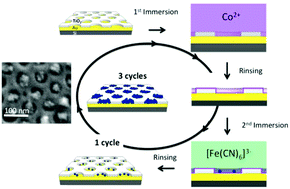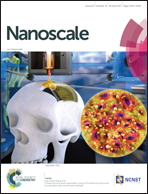Spatially controlled positioning of coordination polymer nanoparticles onto heterogeneous nanostructured surfaces†
Abstract
Prussian Blue Analog (PBA) nanoparticles were formed on a heterogeneous nanostructured surface made of an ordered nanoperforated titanium oxide thin film deposited on a gold layer. The study of the nanocomposite film by grazing-incidence wide angle X-ray scattering, infrared spectroscopy, scanning electron microscopy and atomic force microscopy shows that the PBA particles are precisely positioned within all the perforations of the oxide film over very large surface areas. Further investigation on the formation of the PBA particles demonstrates a decisive role of a heterogeneous nucleation of the coordination polymer driven by well-adjusted surfaces energies and reactant concentrations in the spatial positioning of the PBA particles. Thanks to the well-controlled positioning of the particles within the ordered nanoperforations, the latter were successfully used as nano crucibles for the local transformation of PBA into the corresponding metal alloy by heat treatment. The thin film heterostructure thus obtained, made of ferromagnetic islands isolated by diamagnetic walls, opens interesting perspectives for the design of magnetic storage devices.



 Please wait while we load your content...
Please wait while we load your content...